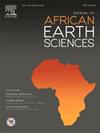Petrography and geochemistry of volcanic rocks of the Kulf-Amba area, in the Northwestern Ethiopian plateau: Implication for petrogenesis of felsic volcanic suites
IF 2.2
4区 地球科学
Q2 GEOSCIENCES, MULTIDISCIPLINARY
引用次数: 0
Abstract
The Kulf-Amba area, located on the Northwestern Ethiopian plateau, is primarily composed of Cenozoic volcanic rocks with minor intertrappean sediments. To understand the petrogenesis of these rocks, we conducted field investigations, petrographic studies, and geochemical analyses. The main volcanic products include basalt (upper and lower), rhyolite lava flows, rhyolitic ignimbrite, volcanic glass, and agglomeratic tuff. Basalts exhibit aphanitic, porphyritic, and glomerophyric textures, with phenocryst of olivine, Ca-rich plagioclase, clinopyroxene, and Fe-Ti oxides. Felsic rocks display porphyritic, aphyric, and glassy textures, with phenocryst of quartz, alkali feldspar, and Fe-Ti oxides. Geochemical data reveal a bimodal composition. The mafic rocks resemble high titaniferous (HT2) basalts of Northwestern Ethiopia and are classified as transitional to tholeiitic. Felsic rocks are primarily peralkaline comendites. The mafic rocks exhibit a depleted heavy rare earth element (HREE) pattern with (Dy/Yb)N = 1.75–2.02 and enriched light rare earth element (LREE) values with (Ce/Yb)N = 7.16–9.26, without a significant negative Eu anomaly. Enrichment in LREE with (Ce/Yb)N = 6.27–15.03 and flat HREE with (Dy/Yb)N = 1.23–1.79, with varying Eu negative anomaly are characteristics of the felsic volcanic rocks, indicating removal of plagioclase throughout their evolutionary process. The consistent Nb/Ta (17.29–23.67 ppm) and Zr/Hf (37.53–45.08 ppm) ratios in both mafic and felsic rocks suggest that fractional crystallization was the dominant process in their formation, with small crystal contamination. The primitive mantle-normalized variation diagram for the mafic rocks reveals LREE enrichment and HREE depletion, indicating garnet in the source. Melting models using primitive mantle normalized values of Sm/Yb vs. La/Sm ratios further confirm garnet's presence and suggest a low degree (2%) of partial melting a source with less than 2% of garnet. The trace element signatures and geochemical modelling of the mafic lavas indicate a plume-related origin, potentially related to the Afar mantle plume.
埃塞俄比亚西北高原 Kulf-Amba 地区火山岩的岩石学和地球化学:对长岩火山岩组岩石成因的影响
库尔夫-安巴地区位于埃塞俄比亚西北部高原,主要由新生代火山岩和少量陆相沉积组成。为了了解这些岩石的成岩过程,我们进行了实地考察、岩石学研究和地球化学分析。主要的火山产物包括玄武岩(上部和下部)、流纹岩熔岩流、流纹质火成岩、火山玻璃和团块凝灰岩。玄武岩呈现闪长岩、斑长岩和辉绿岩质地,表晶为橄榄石、富钙斜长石、霞石和铁钛氧化物。长英岩呈现斑状、斑状和玻璃质纹理,表晶为石英、碱性长石和铁钛氧化物。地球化学数据显示了双峰成分。岩浆岩与埃塞俄比亚西北部的高钛玄武岩(HT2)相似,被归类为过渡至透辉岩。长英岩主要是围岩。黑云母岩呈现出贫化的重稀土元素(HREE)模式,(Dy/Yb)N = 1.75-2.02,富化的轻稀土元素(LREE)值(Ce/Yb)N = 7.16-9.26,没有明显的负 Eu 异常。LREE值(Ce/Yb)N = 6.27-15.03,HREE值(Dy/Yb)N = 1.23-1.79,Eu负异常值各不相同)的富集是长英质火山岩的特征,表明在其演化过程中斜长石被移除。黑云母岩和长英岩中一致的 Nb/Ta (17.29-23.67 ppm)和 Zr/Hf (37.53-45.08 ppm)比率表明,碎裂结晶是它们形成的主要过程,晶体污染很小。岩浆岩的原始地幔归一化变化图显示出 LREE 富集和 HREE 贫化,表明来源为石榴石。利用原始地幔归一化的 Sm/Yb 值与 La/Sm 比值建立的熔融模型进一步证实了石榴石的存在,并表明石榴石含量低于 2% 的岩源部分熔融程度较低(2%)。岩浆岩的痕量元素特征和地球化学模型表明其来源与羽岩有关,可能与阿法尔地幔羽流有关。
本文章由计算机程序翻译,如有差异,请以英文原文为准。
求助全文
约1分钟内获得全文
求助全文
来源期刊

Journal of African Earth Sciences
地学-地球科学综合
CiteScore
4.70
自引率
4.30%
发文量
240
审稿时长
12 months
期刊介绍:
The Journal of African Earth Sciences sees itself as the prime geological journal for all aspects of the Earth Sciences about the African plate. Papers dealing with peripheral areas are welcome if they demonstrate a tight link with Africa.
The Journal publishes high quality, peer-reviewed scientific papers. It is devoted primarily to research papers but short communications relating to new developments of broad interest, reviews and book reviews will also be considered. Papers must have international appeal and should present work of more regional than local significance and dealing with well identified and justified scientific questions. Specialised technical papers, analytical or exploration reports must be avoided. Papers on applied geology should preferably be linked to such core disciplines and must be addressed to a more general geoscientific audience.
 求助内容:
求助内容: 应助结果提醒方式:
应助结果提醒方式:


